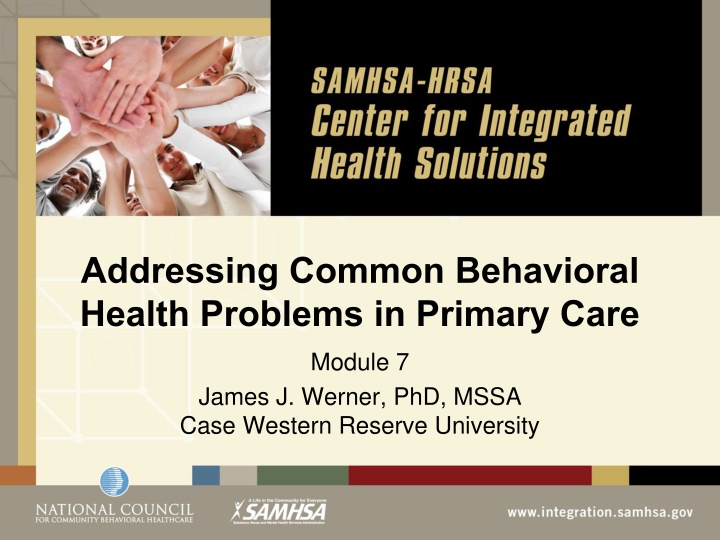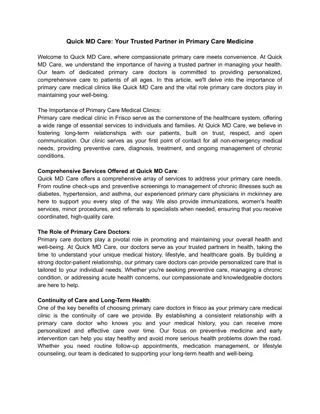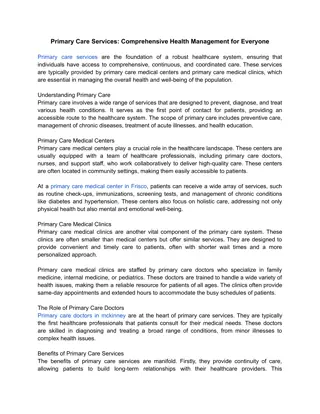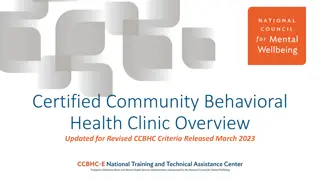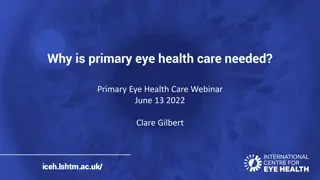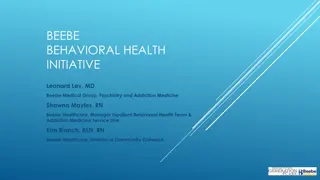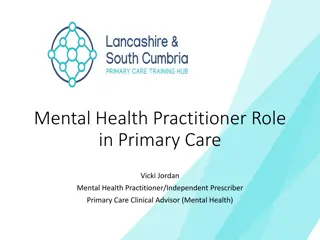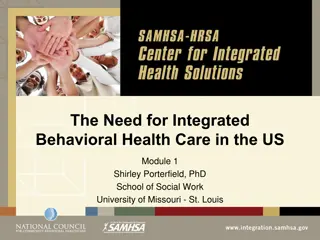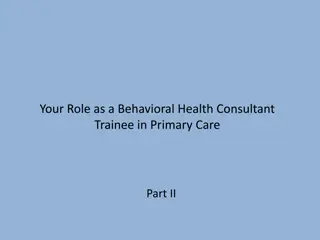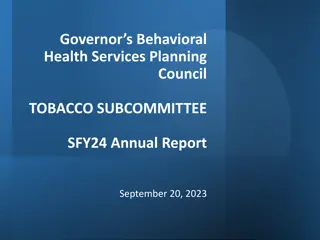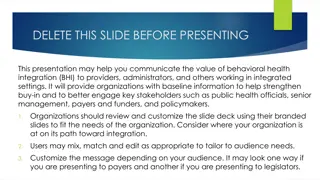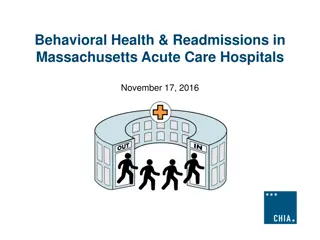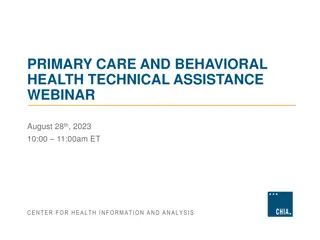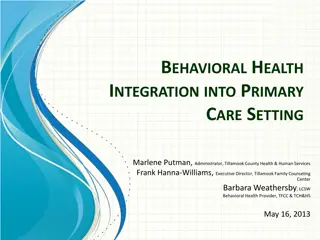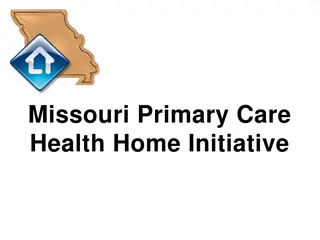Behavioral Health in Primary Care: Understanding and Addressing Common Problems
Patients visiting primary care often present with physical symptoms that lack clear biological causes, indicating the importance of considering behavioral factors. Up to 70% of primary care visits are related to behavioral health needs, stressing the significance of addressing unhealthy lifestyle behaviors and common behavioral disorders. This module aims to equip healthcare providers with a direct practice framework to effectively tackle prevalent issues like depression and diabetes within a primary care setting.
Download Presentation

Please find below an Image/Link to download the presentation.
The content on the website is provided AS IS for your information and personal use only. It may not be sold, licensed, or shared on other websites without obtaining consent from the author.If you encounter any issues during the download, it is possible that the publisher has removed the file from their server.
You are allowed to download the files provided on this website for personal or commercial use, subject to the condition that they are used lawfully. All files are the property of their respective owners.
The content on the website is provided AS IS for your information and personal use only. It may not be sold, licensed, or shared on other websites without obtaining consent from the author.
E N D
Presentation Transcript
Addressing Common Behavioral Health Problems in Primary Care Module 7 James J. Werner, PhD, MSSA Case Western Reserve University
Learning Objectives Understand the magnitude, prevalence, and health effects of: Behaviorally-related health problems Unhealthy lifestyle behaviors Common behavioral disorders Learn a direct practice framework for addressing common health problems, unhealthy lifestyle behaviors, and behavioral disorders in primary care Learn methods used by primary care behavioral healthcare providers to effectively address depression and diabetes
Most Common Reasons for Primary Care Visits4 Top 10 reasons why patients obtained primary care in 2009 diabetes hypertension stomach pain cough throat symptoms knee pain back pain fever vision problems headache These accounted for ~1/3 of all U.S. primary care visits
These appear to be purely physical health problems, but 5 Clinicians can identify a biological cause for only 16% of most common physical complaints The majority of patients coming to primary care have no discoverable organic disease
Behavioral Factors are Highly Relevant in Primary Care5 Behaviorally-related physical complaints Up to 70% of primary care visits are related to behavioral health needs Behavioral health disorders 1 in 5 Americans are affected by behavioral health disorders during any given year 50% of all behavioral disorders are treated in primary care Health behavior issues On average, 97% of Americans need to change one or more health behaviors to maintain or regain health
Discussion 1) Why is it that only a small proportion of patients seeing primary care providers have clear biological causes for their illnesses? 2) What other factors may be causing patients to experience illness symptoms? 3) What types of personnel are needed in primary care to most effectively meet the majority of patients needs? What skills should they have?
Behavioral Health Provider (BHP) Services in Primary Care Collaborate with primary care providers to assist patients experiencing: A need to improve health self-management skills A need to change unhealthy lifestyle behaviors Somatic symptoms of known or unknown origin A wide range of mental health problems including depression, anxiety, substance abuse, and psychosocial stressors Adjustment problems following loss of function Distress over a diagnosis or progression of disease Many other types of health issues
5 As Model A Flexible & Patient Centered Approach to Assessment and Intervention Integrated approach to assessment and intervention Well-established & evidence-based Familiar to PC clinicians & PC teams Can be applied to any patient with any problem Highly adaptable to the preferences of patients
5 As Model 1) Assess Risk factors, behaviors, symptoms, attitudes, preferences 2) Advise 5) Arrange Specify options for treatment, how symptoms can be decreased, & how functioning & quality of life can be improved Specify plans for follow- up (visits, phone calls, e- mail reminders) Personal Action Plan 1. List goals in behavioral terms. 2. List strategies to change health behaviors. 3. Specify follow-up plan. 4. Share the plan with the healthcare team. 3) Agree 4) Assist Collaboratively select goals based on patient interest and motivation to change Provide information, teach skills, and help problem-solve barriers to reach goals
5 As: Assess Objectives Determine what is associated with patient s problem Determine what could change in order to decrease symptoms or improve functioning Assess patient s motivation for change Actions Gather information on symptoms, thoughts, emotions, behaviors, family, friends, & environment
5 As: Advise Objective Describe to the patient the range of potential interventions and expected outcomes Actions Using information from the Assess step, describe to the patient the various options for intervention Discuss the implications of each intervention for the target outcomes specified by the patient Use Motivational Interviewing with patients not ready to take action
5 As: Agree Objective Enable the patient to decide on best course of action on basis of options discussed in the Advise stage. Actions Engage and support the patient in the process of considering options for intervention Allow patient to suggest new options not previously discussed Give patient time and space to consider options and discuss them with significant others
5 As: Assist Objective Help the patient implement the agreed-upon intervention Develop new skills, solve problems, overcome barriers, implement behavior changes Actions Support the patient s efforts to implement the intervention
5 As: Arrange Objective Specify the patient s plan for follow-up with the BHC, PCP, specialty mental health provider, or other provider Actions Advise and assist the patient in arranging follow-up appointments Communicate the patient s follow-up plan to others on the healthcare team If follow-up is with BHC, discuss the focus of the next appointment
Discussion 1) How does the 5 A s model s Assess step compare to the assessment procedures you currently use at your field placement/internship site? 2) The 5 A s model is a clinical framework for addressing a wide range of health conditions. Can you apply the model to one of your current clients at your internship? 3) What issues should be considered when using the 5 A s model with patients of different cultures?
5 As Model for Initial Consultation Visit1 Introduce behavioral health consultation service (1-2 min.) Assess Identify/clarify consultation problem (1 min.) Conduct functional assessment (12-15 minutes) Advise Summarize understanding of the problem (1-2 min.) List possible change-plan options (1-2 min.) or begin Motivational Interviewing Agree Engage the patient in determining a course of action, if any Assist Start a change plan (10 min.) Arrange Determine and discuss next steps; communicate plan to healthcare team Total time: 30 minutes
Applying the 5 As to Two Common Primary Care Problems Depression Diabetes
Depression1 10%-30% of PC patients have depression Frequently unrecognized by PCPs Time-limited psychotherapies often effective when combined with antidepressant treatment Patients with mild to moderate depression can be effectively treated in PC Referral may be needed for patients with higher levels of severity
Depression1 Assess: Introduce, identify, clarify Assess the patient s goals and motivation What does the patient want to change? What are the patient s levels of motivation and confidence? Conduct symptom assessment Tools: PHQ-2, PHQ-9, MDQ, SIGECAPS Conduct functional assessment Onset, duration, intensity, frequency, effects on functioning Potential biological causes: thyroid disorders, nutritional deficits, neurological damage (eg, head trauma, stroke), substance use Suicidal ideation: history, precipitants, frequency, method, impulsivity Assess medication adherence if antidepressant has been prescribed
Depression1 Advise Use handout to explain the typical downward spiral of depression Identify the patient s solutions: Inquire about what has helped patient with depression previously, and what they were doing differently then vs. now (ie, Solution-Focused exceptions & differences questions) Discuss options Consider antidepressant prescription, watchful waiting, referral to specialty MH, & options suggested by the patient Develop a plan Present evidence-based options for depression: behavioral activation, cognitive disputation, problem-solving, patient s own method Describe what each option involves and how it may help Begin motivational interviewing with patients not ready to take action
Depression1 Agree Engage the patient in discussing the options put forth in the Advise step Allow the patient to suggest new options of her own Give the patient the opportunity to discuss options with family or friends if they wish A follow-up appointment may be necessary to discuss the options further
Depression1 Assist Implement one or more interventions chosen by the patient Selected Intervention: Behavioral activation Help the patient set specific and realistic goals to increase enjoyable and meaningful activities Explain why and how the patient should monitor her mood daily Handout tool is available
Depression1 Assist (continued) Selected intervention: Cognitive disputation Ask patient to identify her own unhelpful thoughts Teach patient how to question the accuracy of these thoughts Teach patient to challenge distorted thoughts, and to choose to think and respond differently If this method fails to achieve the patient s objectives, use a stepped care approach to intensify treatment Employ more comprehensive cognitive therapy (or refer the patient if this method exceeds the BHC s available time) Teach: the 8 common types of cognitive distortions; tracking and categorizing thoughts; tracking emotions and behaviors
Depression1 Assist (continued) Selected intervention: Problem Solving a) Help the patient identify and define the problem b) Brainstorm solutions with patient c) Assist patient in evaluating possible solutions d) Assist patient in selecting a solution to try e) Assist patient in developing methods for assessing outcomes f) Ask patient to describe how she plans to implement the method g) Assess outcomes with patient in a follow-up visit h) If outcomes are not favorable, return to step d
Depression1 Arrange The number of necessary follow-up visits can vary greatly between individuals If patient is not having success after 2 or 3 visits and barriers are difficult to overcome, consider referral to specialty mental health Communicate with PCP about patient s preferred approach Keep PCP apprised of patient s progress
Activity 1. How might a BHP and a PCP effectively collaborate to provide higher quality care to a depressed patient than either one could alone? 2. How could the PCP and BHP reduce stigma for a patient who is uncertain about being referred for the first time to a BHP?
Diabetes2 Prevalence of diabetes in U.S. (2010) 25.8 million people have diabetes in the U.S. 8.3% of the total population 11.3% of Americans age 20 and over Up from 8.7% in 2002 26.9% of Americans age 65 and over Up from 18.3% in 2002 Prevalence of pre-diabetes in U.S. (2010) 79 million adults in U.S.
Diabetes2 Type II: begins as insulin resistance. As the need for insulin rises, the pancreas gradually loses its ability to produce it. 90-95% of all diagnosed cases Type 1: develops when the body's immune system destroys pancreatic beta cells, the only cells in the body that make the hormone insulin that regulates blood glucose. ~5% of all diagnosed cases of diabetes. Gestational: Hormones during pregnancy contribute to insulin resistance. Diabetes results if the pancreas cannot produce enough insulin due to beta cell dysfunction. ~7% of pregnancies
Diabetes2 Risk factors Obesity / high body mass index (BMI) Sedentary lifestyle Unhealthy eating habits: diet high in fat and sugar, low in fiber High blood pressure & high cholesterol History of gestational diabetes Family history Ethnicity: Hispanic/Latino Americans, African Americans, Native Americans, Asian Americans, Pacific Islanders, Alaska Natives Polycystic ovary syndrome Increased age
Diabetes2 Complications Heart disease Stroke High blood pressure Blindness Nerve damage Kidney failure Amputations Dental disease Depression Others Management Monitor & maintain healthy blood glucose levels Monitor & maintain a healthy weight Maintain a diet high in nutrients and fiber, low in fats and carbohydrates Be physically active Adhere closely to medication regimen (85% are prescribed medication)
Diabetes2 Diabetes is one of the most challenging chronic diseases to self- manage due to: Need to monitor dietary intake and test blood glucose Need to monitor feet, eyes, & renal function Many patients must adhere to complex medication regimens, including self-administration of insulin Increased risk of depressive symptoms Keep in mind that there is significant variability among patients in the level of effort required to manage diabetes Depending on disease severity, psychosocial factors, cognitive variables, other & factors
Diabetes1 Objectives for BHC Collaborate with patient and PCP to improve management of physiological aspects of disease Help patient reduce emotional distress Support patient in maintaining healthy lifestyle behaviors
Diabetes1 Assess Introduce BHC service, identify the problem, clarify the patient s needs Assess the patient s goals and motivation What does the patient want to change and why? What are the patient s levels of motivation and confidence? (MI ruler) Assess relevant psychosocial/spiritual factors (instruments: Diabetes Distress Scale, PHQ-9) Depression Anxiety Stress Anger Loneliness Social/family/spiritual support
Diabetes1 Assess (continued) Assess modifiable risk factors (sources: check medical record, ask patient directly) High blood pressure Obesity/BMI/dietary habits HbA1c levels Level of regular physical activity Frequency of blood sugar monitoring and level of control Medication adherence Summarize your understanding of the problem for the patient and check for agreement Ask the PCP about her goals for the patient and incorporate into next step
Diabetes1 Advise Identify patient s solutions: Inquire about what has helped patient manage diabetes in the past, and what they were doing differently then vs. now (ie, Solution-Focused exceptions & differences questions) Discuss options eg., improving medication adherence, make dietary changes, increasing physical activity, options suggested by the patient Discuss options that interest the patient most Develop a plan Recommend methods for achieving goals, eg., increase frequency of blood sugar checks to 2 times/day, walk for 15 minutes twice each day, use pill organizers, patient s previously successful methods Describe what each option involves and how it can help the patient achieve her goals
Diabetes1 Agree Engage the patient in discussing the options put forth in the Advise step Allow the patient to suggest and discuss options of her own Give the patient the opportunity to discuss the options with significant others A follow-up appointment may be necessary to further discuss options and agree on a plan of action
Diabetes1 Assist The patient will implement one or more interventions they have selected, for example: Maintain a daily self-monitoring log of blood sugar readings Implement a plan to immediately remediate out of range blood sugar levels Walk a targeted number of steps/day to increase physical activity Replace commonly eaten foods that spike blood sugar levels with more healthy choices Take specific actions to decrease depression and emotional distress Increase social engagement with friends and family to improve coping capacity
Diabetes1 Arrange Complex patients are likely to require greater numbers of follow- up visits If patient is not having success after 2 or 3 visits with the BHC: Obtain input from PCP and healthcare team about potential next steps Meet with the patient again to discuss options Consider arranging access to additional resources, eg., diabetes educator, nutritionist, psychiatry referral, diabetes group visits Develop ongoing criteria that specify when the patient should revisit the BHC, for example: If patient gains10 pounds or more Patient s HbA1c goes above 7
Discussion 1) The risk of developing diabetes increases with age. What might be some of the biggest challenges faced by an elderly patient who is newly diagnosed with Type II diabetes? How can a BHC effectively support an elderly patient in meeting those challenges? 2) What other types of programs or services could be helpful to patients when a primary care practice serves a population with high rates of Type II diabetes?
References 1. Hunter, C.L., Goodie, J.L., Oordt, M.S., & Dobmeyer, A.C. (2009). Integrated Behavioral Health in Primary Care: Step by Step Guidance for Assessment and Intervention. Washington, DC: American Psychological Association. 2. National Diabetes Fact Sheet. (2011). Centers for Disease Control and Prevention. Atlanta, GA. 3. Kroenke, K. & Mangelsdorff, A. D. (1989). Common symptoms in ambulatory care: Incidence, evaluation, therapy and outcome. American Journal of Medicine, 86, 262-266. 4. National Ambulatory Medical Care Survey. (2009). Summary Tables. National Center for Health Statistics. Centers for Disease Control and Prevention, Atlanta, GA. 5. Mental Health: A Report of the Surgeon General. (1999). United States Public Health Service. Center for Mental Health Services. National Institute of Mental Health, Washington, DC. 6. Murray, C.J.L. & Lopez A.D. (Eds.) (1996). The global burden of disease: A comprehensive assessment of mortality and disability for diseases, injuries, and risk factors in 1990 and projected to 2020: Vol. 1 of Global Burden of Disease and Injury Series. Cambridge, MA: Harvard University Press. 7. Brownson RC, Remington PL, Davis JR, (Eds.). (1998). Chronic Disease Epidemiology and Control 2nd ed. Washington, DC: American Public Health Association. 8. World Health Organization. (2005). Preventing Chronic Diseases - A Vital Investment. WHO Global Report. 9. Whitlock, E.P., Polen, M.R., Green, C.A., Orleans, C.T., & Klein, J. (2004). Behavioral counseling interventions in primary care to reduce risky harmful alcohol use by adults: A summary of the evidence for the U.S. preventive services task force. Annals of Internal Medicine, 140, 558-569.
